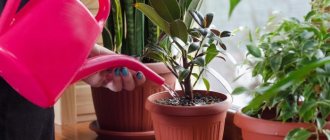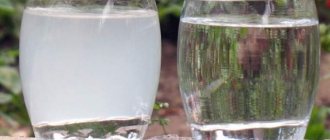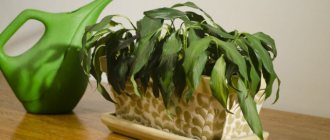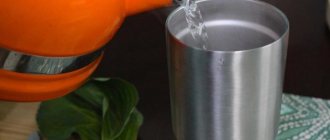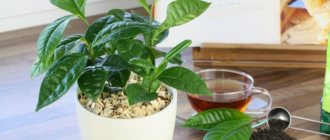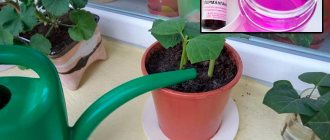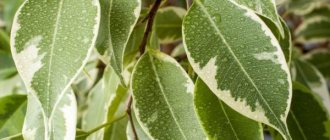The long-awaited harvest of vegetables largely depends on proper watering of the garden. If you are an inexperienced gardener and don’t know how often to water your plants, how many times to water and with what water, all the tips are in our material.
There is little moisture - the greens in the beds wither, the leaves become smaller and curl, the nightshade ovaries fall off, and the root vegetables begin to taste bitter. Too much moisture - vegetables acquire a watery taste, and the roots begin to rot. How to properly water a garden? What to do and how to avoid such troubles? Let's figure it out together.
What determines the frequency of irrigation?
The frequency of watering flowers depends on many factors:
Ambient temperature . In hot weather, more frequent and abundant watering is required.- Air humidity . In a room with dry air, flowers need more frequent watering and spraying.
- Type of substrate . In loose soil, evaporation occurs faster, in heavy soil it takes longer.
- Pot size . If the flower grows in a large pot, then it is necessary to reduce the amount of watering to avoid stagnation of water. If the root system occupies most of the pot, then it is better to increase the number of waterings.
- Type of pot . Plants in clay pots are watered more often than those in plastic pots.
- Location of the pot . Flowers growing on a western or northern window require moderate watering, while those on a southern window require more abundant watering.
- Flower age . A young plant requires more moisture than an adult.
- Activity state . During the period of active growth, the plant requires more moisture, while in a dormant state, minimal watering is required.
- Season . Despite the fact that house flowers are kept warm, seasonal watering must be observed. In the autumn-winter months less moisture is required, in the spring-summer months more is required.
It is better to water an adult flower with less frequency, but with an increase in watering rate.
What types of irrigation exist
Experts distinguish several types of irrigation depending on the purpose of its use:
- planting and post-planting , which improves the survival rate of crops after sowing seeds and planting seedlings;
- the main one is to replenish moisture in the soil during the growing season;
- fertilizing , which allows you to apply dissolved fertilizers;
- refreshing - used at high air temperatures;
- anti-frost – to reduce the risk of plants freezing.
It is advisable to use different types of irrigation in combination. Then the plants will receive everything they need for full development.
How to determine moisture needs?
The fact that the flower lacks moisture is indicated by dry, lumpy soil, dried inflorescences, and drooping leaves.
You can determine the need for watering in the following ways:
- Dry soil can be easily identified with a wooden stick. If it easily penetrates the substrate and remains dry after removal, then this is a reason for watering.
- You can pick up a handful of soil; if it falls apart, then the soil is dry, it’s time to water the flower.
- Dry soil can be determined by tapping the bottom of the pot. It is given away by a ringing sound.
- Moisture indicators, lowered to the depth recommended in the instructions for use, determine soil moisture.
For your information, if the soil contains a large amount of mineral salts, the moisture indicator may be wrong.
Reviews
With experience, each summer resident develops his own algorithm for watering tomatoes in the open ground. Theoretical knowledge is good, but it must be tested in practice. Sometimes adjustments have to be made to the generally accepted scheme due to soil characteristics, climatic conditions and some other factors. Here's what those who have been growing crops for years say about it.
Marianna, Stavropol region:
“At the end of August, I completely stop watering tomatoes to avoid late blight. The bushes survive normally until frosts, which happen in the second half of October. Sometimes the tomatoes don’t turn out as juicy as we would like, but the plants don’t get sick and the harvest is completely preserved.”
Vitaly, Novosibirsk region:
“I have had a purchased drip irrigation system “Aqua Dusya” on my plot for two years now. I'm very pleased with the result. No hassles with buckets, watering cans, or hoses. The fruits are large, the bushes do not get sick. The only difficulty is that the system has to be removed in the winter and installed again in the spring. I’m playing it safe, since our winters are frosty.”
Inna, St. Petersburg:
“The frequency of watering directly depends on the area where the tomatoes are planted and the weather conditions. I’ve heard that some people recommend watering tomatoes only two or three times a season, but I don’t think this is justified. With our wet summer, I water my tomatoes regularly, especially if there is no rain. First of all, you need to be guided by the state of the plants themselves."
How to?
The growth of flowers and their resistance to diseases depend on the nature of watering.
In the garden, at the dacha
If the flowers are located outside, then the frequency of their watering is regulated by weather conditions and seasonality:
- in spring, flowers require moderate watering, 2-3 times a week;
- in summer, the frequency of irrigation increases; in hot weather and in the absence of precipitation, flowers are watered every other day;
- in dry autumn, plants are watered once a week.
In cool, damp weather, plants require little or no additional moisture. It is important to monitor the condition of the soil and avoid oversaturation with water.
If flowers grow on the balcony, then they need to be provided with adequate watering, just like indoor plants, but not forgetting about more frequent spraying.
Indoor
Although indoor flowers grow in constant conditions, they are also directly affected by the season. Let's look at the features of watering flowers at different times of the year:
- Spring is a time of increased development and growth. The frequency of irrigation of the land during this period depends on the air temperature, both indoors and outside, heating, and air humidity. Optimal watering varies between 3-7 days. If it is warm enough outside and the heating has not yet been turned off, then indoor plants need to be watered twice a week.
- Watering in the summer months is done at the same intervals as in the spring, 2 times a week.
- In autumn, watering home flowers is gradually reduced, taking into account the room temperature, air humidity, and soil conditions. Irrigation is usually done once a week.
- During the winter months, water indoor flowers approximately once every 7 days. Some gardeners water their flowers quite rarely in winter, once every 3-4 weeks. It is not right. Such actions can lead to drying out of the soil.
Some flowers prefer to bloom in the cold season; lack of moisture can lead to the cessation of active vegetation. Therefore, irrigation should be carried out taking into account the period of their growth and activity. Flowering plants are watered in winter at the same frequency as in summer.
Characteristics of irrigation water
Not all water has a positive effect on plants. Or rather, for irrigation water there are recommendations on temperature and quality.
Very cold water, as well as too warm water, adversely affects the vital activity of soil microorganisms and the absorption capacity of the root system. In addition, when watering with ice or hot water, plants experience temperature shock, which manifests itself in wilting and sometimes shedding leaves. This reaction is due to the fact that stress inhibits the performance of the root apparatus, while the process of transpiration (evaporation of moisture through the leaves) remains at the same level of intensity.
Thus, the temperature of irrigation water should be oriented towards the optimal soil temperature, at which the most favorable development of plants occurs, and therefore equate to + 15...25 °C. Consequently, if water for irrigation is obtained from a well or borehole, it must be preheated in a specially designated container installed at the highest point of the site.
The quality of irrigation water is no less important. Water with a high concentration of salts (high mineralization is usually observed in ground and mine waters) and undesirably containing a high amount of suspended particles (dirty river or lake water) should not be used for irrigation. You can find out the quality of water through laboratory testing and, based on the indicators, either settle it, or purify it with chemical methods, or water it with tap water, since it usually has average indicators both in the presence of salts and in contamination with suspended particles. However, there is a “fly in the ointment” here - the presence of bleach and fairly low temperatures, but settling again allows you to cope with them.
Rainwater collection tank. © Tanksalot
Schedule
It is important to pay attention to the fact that each plant has its own individual need for moisture.
Watering schedule for some flowers in the table:
| Name | Soil requirements between waterings | Watering frequency per week |
| Begonia | Without drying out the soil | 3 times |
| Ficus benjamina | Severe drying of the soil | 1 time |
| Spurge | Severe drying of the soil | 1 time |
| Spathiphyllum | Without drying out the soil | 2 times |
| Crassula | Drying out the soil between waterings | 1 time |
| Ferns | Constantly wet soil | 2-3 |
| Azalea | Easy soil drying | 2 times |
| Dracaena | Easy soil drying | 1-2 times |
| Zamioculcas | Easy soil drying | 1 time |
| Calathea | Without drying out the soil | 2 times |
Irrigation in the heat
In the heat, flowers feel thirsty, especially if they stand on the south side under the influence of sunlight.
This moment does not always have a positive effect, especially if the air temperature reaches or exceeds 30 degrees. In this case, it is better to move them to a more shaded place.
On the street
Outdoor flowers suffer in the heat, especially if they are planted in the ground and there is no way to move them to the shade.
If the flower grows outdoors in a pot, then it is better to protect it from direct sunlight.
In hot weather, plants require daily watering . It is better to carry out these actions either early in the morning, or between 16-18 hours, in order to prevent stagnation of moisture, which has a detrimental effect on the root system.
Houses in pots
In the hot weather, indoor plants need daily humidity control and must be protected from sunlight. In hot weather, indoor flowers are watered 3 times a week, but spraying must be done every day.
If in the heat the plant is not in direct sunlight, or is not standing on a south-facing window, then watering is carried out as usual, 2 times every 7 days.
In hot weather, flowers are watered in stages: first, we irrigate the soil a little, and after the water is absorbed into the soil, we add the next portion.
Spraying features
From time to time, a spray or shower is simply necessary for our beloved plants. This treatment can be carried out using only water or combined with fertilizing.
For the procedure itself, you will first need a spray bottle. Nowadays there are a large number of their modifications on sale; you need to choose one that allows you to regulate the water pressure.
Only soft water should be used for irrigation, since hard water contains a huge amount of various salts.
Let's consider which plants can be sprayed and which do not like it. Here, in fact, everything is simple.
- You cannot spray flowers with pubescent leaves. These are gloxinia, violets, episcia and the like.
- Rarely and very carefully you can spray flowers that have thin foliage with frills - pelargoniums, caladiums, streptocarpus.
- If the plant has glossy dark foliage, then it can be sprayed. Ficuses, Dieffenbachias, citrus fruits, codiaums, and philodendrons love water treatments.
- And there are also flowers that simply cannot live without spraying. These are azalea, cypress, caladium, fern, plants of the Marantaceae family.
Spraying has its own characteristics, if you ignore them, you can lose the plant. So, let's formulate the basic rules:
- Irrigation of foliage is carried out only when direct sunlight does not fall on it;
- spray only after watering;
- if the plant blooms, you need to make sure that water does not get on the buds;
- in winter, spraying is reduced if the plants are placed on cold window sills, and increased if they are near heating radiators;
- cacti are sprayed very rarely and carefully.
In addition to water, spraying can be done with adaptogens, growth stimulants, and vitamins.
What to do if the plant is flooded?
Both excess and lack of moisture have equally detrimental effects on flowers. Step-by-step actions when flooding a plant:
- As soon as possible, carefully remove the flower with the earthen lump from the pot;
- carefully examine the root system for rot;
- if there are rotten roots, remove them;
- wrap the earthen lump in paper, leave for some time until completely dry, the amount of time depends on the degree of flooding;
- if the plant is heavily overwatered, then carefully soak the root system with a cloth;
- replace the pot or rinse the same one thoroughly and dry it;
- fill in new drainage and substrate;
- replant the flower and avoid overflowing.
Note: after overwatering, the leaves will become limp, turn brown, fall off and rot, and mold may appear on the surface of the soil.
The video will tell you what to do if the plant is flooded:
Theoretical part
A competent approach to watering is the basis of plant care. This problem is especially acute in the summer, because the weather can change frequently: prolonged rains alternate with serious droughts, and it is extremely important to be wise. A good guide in this matter is the state of the land cover in the beds, as well as the appearance of the plants themselves. So, the following indicators of water shortage should alert you:
- Plants stop growing or are noticeably slow in adding green mass.
- Plants begin to wither, shoots lose turgor, foliage droops at lunchtime and does not return to its natural appearance in the evening.
- The leaf blades turn very yellow and dry out.
- There is no flowering, the buds fall off.
- The ovaries do not form, the fruits fall off before they have time to ripen.
- Productivity is falling (especially noticeable on zucchini, tomatoes, peppers, and cucumbers).
However, by drawing up the wrong schedule regarding how often you need to water, you can get the opposite extreme, and excess moisture is no less dangerous:
- The immune system weakens, diseases overcome (fungal infections and rot become especially active).
- The root system gradually rots and dies.
- Plant development slows down due to decreased nutrient concentrations.
By monitoring your garden every day, you can accurately determine the optimal watering schedule.
What to do if you are too dry?
Watering dried flowers is done by immersion. This way you can evenly moisten the soil.
Step by step steps:
- We prepare a container with water, its temperature is from 25 to 30 degrees, more than the size of the pot.
- Place the pot with the plant there for 5-10 minutes.
- If the plant has suffered greatly from overdrying, then the pot should be kept in water until air bubbles stop being released.
- Remove the flower pot from the container.
- Let the water drain.
Note, if after watering the leaves of a wilted flower become elastic, then the plant suffered from overdrying.
The video will tell you what to do if the plant is too dry:
